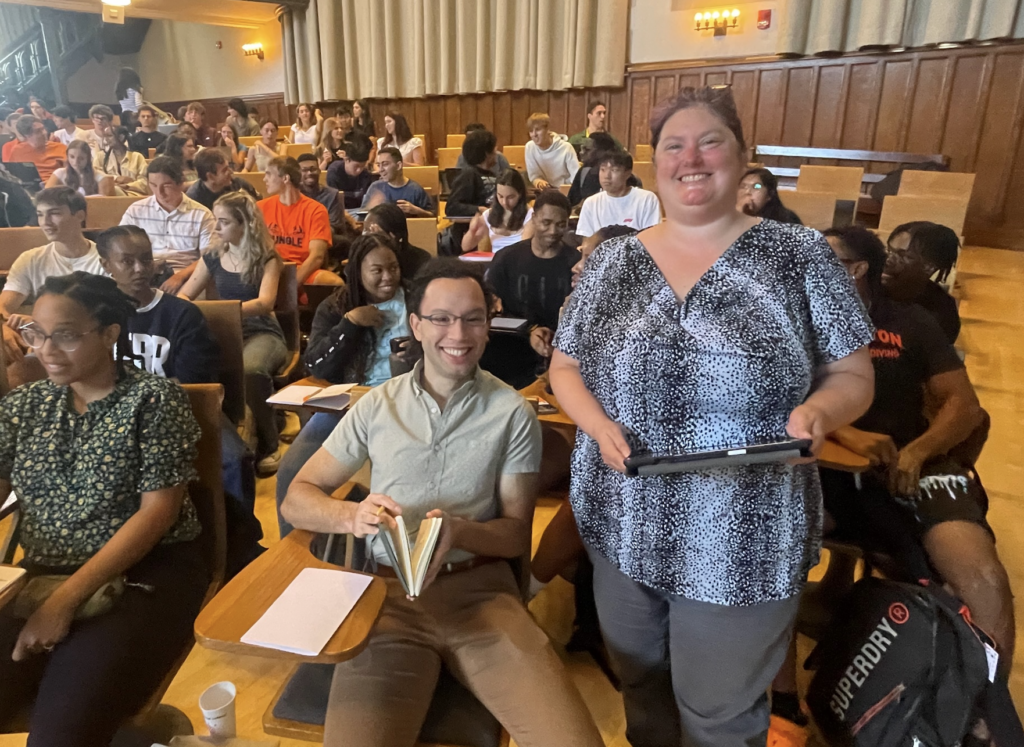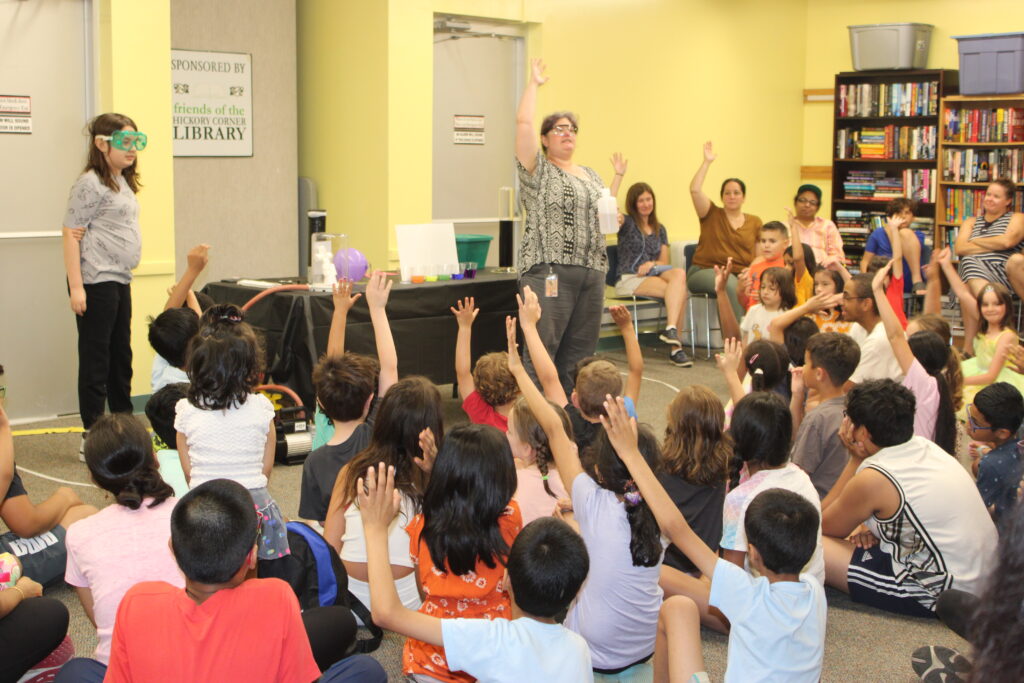“Seeing” the chemistry with Demonstration Lecturer Angela Miller

Spend just a few minutes in the company of Angela Miller, Princeton Chemistry’s lecture demonstrator, and it becomes obvious why she is a perfect fit for the job.
Declarative, confident, and very good at reading a room, Miller helps demystify the workings of chemistry in the big core courses like GenChem, with its 300 students, and in outreach programs across Mercer County that tap new generations of scientists.
She was hired a year ago to lead the demonstrations that support classroom lectures, and also to expand on the Department’s community outreach. Today, she does that with colors and lights and the occasional explosion (she blew up a pumpkin for Halloween last year). But the real secret behind her success is the gusto she brings to each audience. She keeps them enthralled. She questions their assumptions. She tosses out sentences like these as if she’s throwing candy:
“The most important phrase in science is not ‘Eureka.’ It’s, ‘Huh … that’s interesting.”
“I love chemistry. I love when people also love chemistry.”
“It’s not magic. It’s science.”
“It helps if you’re curious. Are you curious?”
“I have two degrees: one in chemistry and one in art history. I know, right?”
“You have to be very extroverted. I’m very extroverted.”
One year into her position at Princeton, Miller is sure of one thing. A good demonstration can make use of smoke and mirrors, yes, but it’s never about deception. She draws a firm distinction between most science demos, which she calls “magic shows,” and her own, in which the point is to make the science clearer. Miller uses a cache of recipes developed over almost 15 years to introduce students to important concepts. For kinetics, the Iodine Clock; for equilibrium, Cobalt Complexes; for solubility, the Ammonia Fountain or Like Dissolves Like.
“The thing that bugs me about the way that general chemistry is taught at most places is that they make it so boring. And it’s not boring. It’s so cool,” says Miller. “So, I bring in: this is why we know what stars are made of, or this is why you need to drink Gatorade after a heavy workout. It helps students realize that chemistry isn’t just this dusty thing you learn in a textbook so you can go to medical school.
“When I’m with the Gen Chem students, I’m usually presenting a demo to illustrate a specific topic in chemistry. It’s one thing to know about the ideal gas law (PV=nRT), and a completely different thing to see for yourself that decreasing temperature will decrease volume, or decreasing pressure will increase volume.
“There is just so much to show. And I love showing it.”
From there to here
Miller grew up in Pittsburgh with a background that would not surprise others in her field, which is to say that she almost burned her house down several times. “I was lining up Dixie cups and doing experiments when I was seven.”
An all-girls high school in Pittsburgh gave Miller the chance to explore her science aptitude unselfconsciously. Her abilities confirmed, she went on to Oberlin College where she got undergraduate degrees in chemistry and in art history.
Miller started her Ph.D. at the University of California, Berkeley, but was not happy there and left before completing the program. Instead, she ended up taking a position at Ohio State University based on a posting for a demo job a friend mentioned, telling her: “This sounds like you.”

Miller doing some science outreach with the Mercer County Library System this summer.
She started at OSU in 2010 and immediately began overhauling the wheelhouse.
“The lab was a huge mess. The paperwork was a huge mess. It took me about a year to get it all organized,” says Miller. “I learned that I’m really good at writing instructions, because I rewrote all of the recipes for all the demonstrations so they’d be consistent.
“I used to hand out a 50-page menu with every single demo we had organized by subject. Professors or lecturers would either email me or use a form to tell me what they wanted, and we would prep it and bring it to class and set it up for them. It was very much like a restaurant.”
Miller stayed at OSU for 13 years, preparing for some 1,500 demonstrations every semester.
She joined Princeton last August. The position, she says, has a more collaborative feel to it, where professors talk over with her what they’re looking for: “It’s less of a menu place.” Many of the demo recipes she inherited were incomplete, so Miller largely uses those she brought from OSU and modifies them accordingly. She can demonstrate equilibrium. She can demonstrate solubility. She can demonstrate kinetics. She can segue into physics.
Whatever it takes to get the point across.
“It’s obvious from the way students will flock to Angie after lecture–with questions about both lecture material and pure curiosity–that she has a profound impact on the students’ understanding of chemistry and on the students’ sense that general chemistry can be a welcoming place,” says Corey Clapp, a lecturer in chemistry who was ringside last semester when Miller participated in her first class.
Professor of Chemistry Michael Hecht, who teaches GenChem, adds: “It’s been great working with Angie. She approaches demonstrations from two perspectives: Using the demonstrations to make science comprehensible and using demonstrations to make science fun.”
This academic year, Miller will be a front-row fixture in all the GenChem courses, from the normal-sequence classes 201 and 202 to 207 (specifically designed for engineers) and 215 (for students who got a “5” on their AP class). There, students will begin to grasp through her demonstrations the scientific method in a visceral way.
“I believe that demos should be done in a particular way. I want them to raise their hands and give me ideas,” says Miller. “Every time we do something, I give them a limited amount of information and then I have them make a prediction. Then we test it.
“You can read all about an Iodine clock and how the rate of the reaction depends on concentration, and you can say, ‘oh yeah, that makes sense,’ “ she adds. “But then when you see it, it’s like, oh that’s what you mean. It’s that last step to making a concept click in your head. It’s a totally different thing to see it.
“And that’s what I do. With me, they see the chemistry.”
